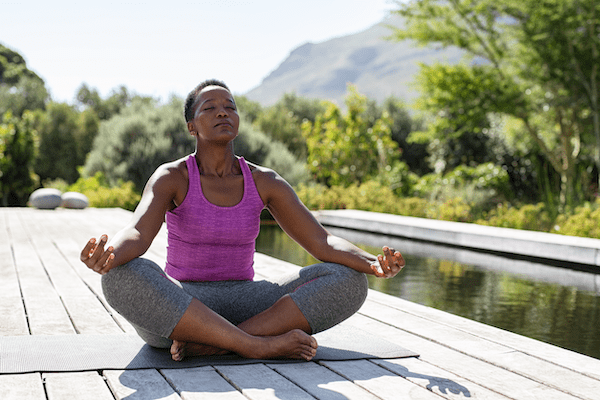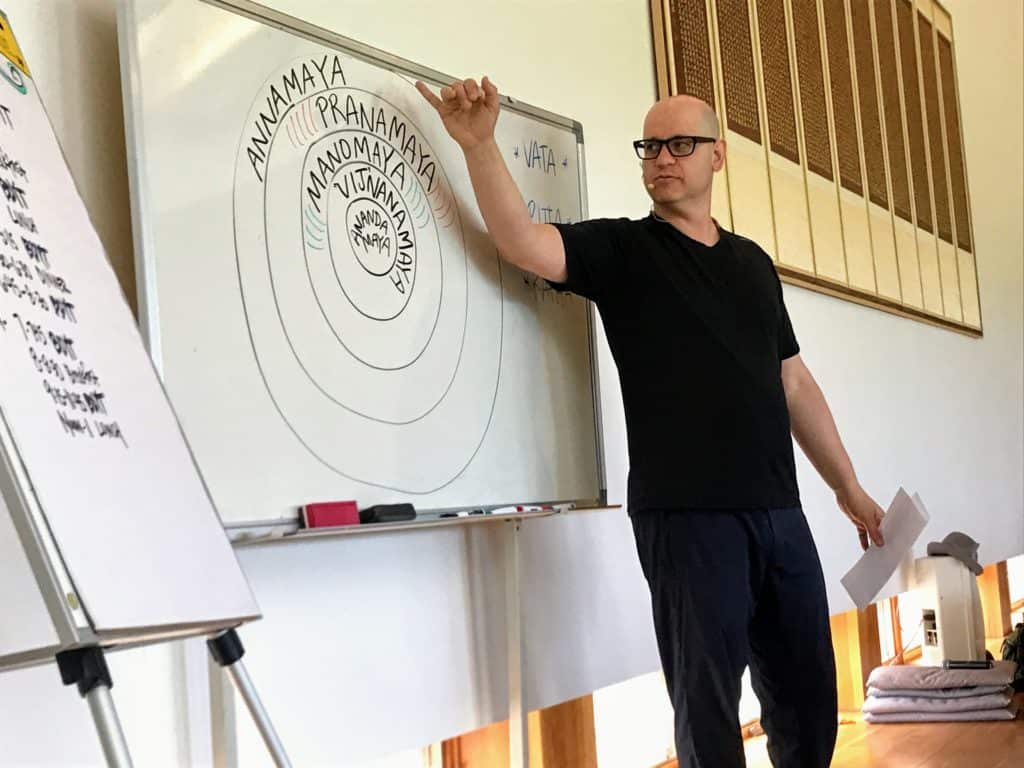
Massage therapy is a rewarding but demanding career. I would know—I’ve been a medical massage therapist myself for over 20 years. Looking for a way to make massage therapy a more sustainable job, supplement your income, advance your career, and better serve your clients? Yoga and massage therapy could be the perfect solution.
I’m Brandt Passalacqua, the Co-Founder, Director, and Lead Teacher of Breathing Deeply Yoga Therapy. It has been my honor to help thousands of yoga therapy clients and students, and I hope I can help you too.
Keep reading to learn about the benefits of yoga for massage therapists and their clients, how to get started with yoga training for massage therapists, and more. If you’d like to start a conversation with us about your career or our program, please feel free to contact our team.
Table of Contents:
Studies estimate that massage therapists last only 3 to 5 years on average before leaving massage therapy, according to Massage Magazine. Reasons why MTs burn out include:
Massage therapy is physically demanding work, which limits how many clients you can see each week. In my experience, most massage therapists can’t see more than 15 clients per week. Many can’t see more than 10 clients per week, capping out at 2 per day, due to the physical toll. This often makes it difficult to make ends meet without taking on additional work.
Then there are the clients themselves and your ability to help them. Massage therapists can make a real difference to many clients, but there are usually a few who keep coming back, time after time, asking for help with the same aches and pains. You want to help, but you’re at a loss for what else to do. It’s frustrating to realize that you’re limited in your capacity to heal those clients.
Not only do you need to work with clients, but also you need to work on running your business—marketing yourself, building client relationships, and seeking referrals. It’s no wonder that this job starts to take a toll.
Fortunately, there are a lot of opportunities in yoga for massage therapists. Yoga therapy can easily integrate into a massage therapy career. It allows you to make the most of the skills and business you’ve already established, while also expanding them.
Interested in advancing your career? Yoga therapy involves the therapeutic application of yoga techniques to specific physical, spiritual, emotional, and mental health issues. For more information, check out our blog post on the difference between a yoga teacher and yoga therapist.
There are a number of advantages that come with combining yoga and massage therapy, from expanding your scope of practice, to leveraging existing relationships, getting more referrals and demand, and safely increasing your client load.

Expanding your practice to include both yoga therapy and massage therapy can exponentially grow your business. Most clients are looking for holistic care, and many may already be interested in finding other healthcare modalities like yoga to complement massage. Why not be the one to supply them?
Even clients who don’t know about yoga therapy or haven’t been considering yoga will likely be interested if you explain how your yoga therapy services can help with the issues they’re facing. By expanding your skill set, you have more tools at your disposal when a client comes to you with a problem. This not only helps your client, but also helps you be more effective and reduce the risk of burnout.
With yoga therapy, you can effectively double your client load without hurting yourself. Yoga therapy isn’t hands on like massage therapy is, and you don’t have the same physical demands as a yoga therapist.
Ultimately, it’s about enhancing your career’s potency while providing more options to those you serve.
As a massage therapist, you already devote significant time and effort into cultivating strong relationships with your clients. You also put resources into marketing yourself and finding new clients that way. What if you could double the return on your investment?
The solution could lie in yoga for massage therapists. If you’re trained in yoga and massage therapy, every client could potentially be worth double if you end up booking them for massage therapy and yoga therapy appointments.
Every piece of advertising suddenly has double the potential as well. It could catch the eye of someone looking for massage or yoga, and once they’re in the door, you can always explain to them the advantages of both these services.
Your current clients already trust and respect you. If you become a yoga therapist and recommend that they try those services, many of them will listen! You can also ask them for referrals, giving you another source of potential clients.

Not only does expanding your scope with yoga and massage therapy potentially double the number of appointments for each client, but it also can make your services more in demand and garner you more referrals.
By adding to your skill set, you’re already making your services more valuable. As a professional who can provide both yoga and massage therapy, your services will stand out and rise in demand. This also enables you to offer more solutions and holistic care to clients, which leads to better results, which leads to higher client satisfaction, which leads to more referrals.
As those referrals turn into new clients, the cycle continues!
As mentioned above, offering both yoga and massage therapy can help to attract more clients. It also allows you to take on more work safely, without risking injury like you would by taking on additional hours of massage therapy.
Yoga therapy prioritizes trauma-sensitive approaches that don’t involve touching clients. While we may sometimes perform muscle assessment (with consent) to help evaluate the physical body, we generally avoid hands-on adjustments or other physical contact. Instead, we invite clients to perform certain actions and teach them how to practice them and align their bodies correctly themselves.
With all of this in mind, working as a yoga therapist is not a physically demanding job. It allows you to schedule additional appointments with clients, while still getting the appropriate rest between massage therapy sessions.
Going through yoga training for massage therapists isn’t just good for your career, it’s good for your clients as well. From making your interventions more effective and providing clients with more holistic healthcare, to giving clients more agency and reducing the number of appointments they need to make and specialists they need to see, combining yoga and massage therapy is a win-win scenario.
Getting effective treatment is most clients’ top concern. No one wants to spend time and money on things that won’t help them. Even worse is experiencing a persistent pain or problem that won’t go away and not knowing how to fix it.
With skills in both yoga and massage therapy, you have more potential solutions to offer your clients. If you end up seeing a client for both yoga therapy and massage therapy sessions, your care will also be more holistic. Both result in better outcomes for clients.
Combining yoga and massage therapy is particularly effective. It allows you to work on the client yourself as a massage therapist, while also teaching them how to continue care at home with yoga techniques. For example, you might manually lengthen a client’s hamstrings yourself during a massage therapy session, then teach them techniques to do at home. With this extra time devoted to their care between sessions, they can see better and faster results.
When clients work with multiple specialists, it’s all too easy for their healthcare treatments to stay separate. This creates care that can be disjointed. When healthcare providers work together, they can provide more holistic healthcare for a client. This is even easier if their massage therapist and yoga therapist are the same person.
You see the client more often, get more updates about their health, and have more opportunities to intervene. As their massage therapist and yoga therapist, you can ensure that the interventions for each of these modalities are complementing one another and taking the other into account.

Massage therapists fix people when they’re on the table. Yoga therapists help people learn how to fix themselves, giving them more agency over their health.
Clients are empowered to use yoga techniques at home and on their own, without needing to wait until they have access to a professional or a piece of equipment. Not only does this produce better outcomes for clients, but it also increases their satisfaction with their treatment.
People have a lot of options when they’re injured or in pain. They can see a medical doctor, a physical therapist, an occupational therapist, a chiropractor, an acupuncturist, a massage therapist, a yoga therapist, or, in some cases, even a mental health professional. It can quickly become overwhelming!
If you’re able to offer them yoga and massage therapy, they can get both of these services from one professional at one location. Your clients also save time and energy that would have been spent researching additional specialists, getting set up, going through their history and current treatments, and scheduling appointments.
Plus, you’ll know which sessions will serve them best and at what cadence. They can rest assured that they’re making the most of their massage therapy and yoga therapy, without accidentally booking a yoga therapy appointment too soon after a massage therapy session, for example, when their muscles are still recovering.
With all of this in mind, there are still more benefits of yoga for massage therapists. Whether it’s moving more quickly through certain material that you’re comfortable with already or gaining additional knowledge and skills, there are many ways that these two fields can complement one another. Plus, you’re still able to work for yourself, taking advantage of the benefits of self-employment and doing more with the work you already put into your business.
The knowledge you’ve already gained as a massage therapist gives you a leg up on preparing to become a yoga therapist. There is a notable amount of overlapping knowledge in yoga and massage therapy, including:
Both professions also learn about specific health conditions they are likely to encounter. For massage therapists, this usually includes skin diseases, nervous system disorders, respiratory system disorders, back problems, and neck problems, giving you an advantage as a yoga therapist who could come across those same conditions.

By studying yoga therapy, you can gain an even better understanding of the body, enhancing both sets of skills. This includes:
After completing yoga training for massage therapists, you’re also equipped to handle an even wider range of physical, spiritual, emotional, and mental health conditions with yoga therapy.
Studies suggest that massage could reduce issues related to anxiety and depression, as discussed in Focus, the American Psychiatric Association’s quarterly clinical review journal. But massage therapists are generally focused on the physical body and lack training on treating mental health conditions.
By contrast, yoga therapists heal minds as well as bodies. We are also trained on using a trauma-informed approach, allowing us to safely and effectively serve these clients.
With yoga therapy training, you can learn new skills that enable you to help clients who have experienced trauma and those who want to heal from a wide variety of mental health conditions.
Many massage therapists have an entrepreneurial streak, enjoy setting their own schedules, or prefer self-employment. Practicing as a yoga therapist allows you to continue working for yourself while getting more returns from these efforts:
Invest in yoga training for massage therapists and your body, your clients, and your business will thank you. Remember, as a self-employed health professional your most valuable asset is yourself!

Interested in yoga training for massage therapists? Consider applying to our yoga therapy school!
As an experienced massage therapist and yoga therapist myself, I believe I am uniquely qualified to help you achieve your goals. We pride ourselves on the flexibility of our program to fit into your schedule and finances, with 24/7 access to online lessons and pay-as-you-go plans.
Our students also benefit from direct mentoring through multiple weekly live interactive Q&As as well as lifetime access to our community of teachers and students. We provide more visual and experiential learning than traditional academic degrees, working hard to ensure that every student has a learning environment that suits their needs.
Learn more about our programs, start a conversation with our staff, or apply to our school today. I hope to be a part of your journey!
Brandt talks about common questions applicants have about the Breathing Deeply Yoga Therapy Program. Tune in to get the full program details.
Friends in Yoga, The way we perceive the world is a curious thing. Is it on fire or getting better? Are we facing our challenges or shying away from them? Are we functioning from the present or some altered reality based on past experiences? The teachings tell us that reality is ultimately timeless. The vibration […]
There’s no doubt that yoga is gaining popularity, but you may be asking yourself, what is the most popular type of yoga? Where is each type most popular in the U.S. and around the world? And for those who are interested in trying it themselves, how can you practice these styles of yoga safely? For […]
Friends in Yoga, Sitting on a cushion, taking a yoga class, chanting a mantra before your morning coffee…no one would call these radical acts. They are small choices that we make to better ourselves. The motivation to practice often takes form by our desire to be healthier, to be more focused, to connect with our […]